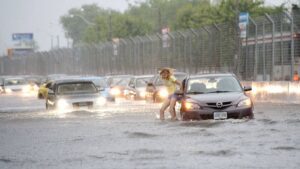Flooding and Mold
Flooding and Mold
The Toronto Star has an interesting article out today titled, Water is the New Fire, (https://www.thestar.com/news/canada/2018/03/05/water-is-the-new-fire-says-the-insurance-bureau-of-canada-as-researchers-point-to-development-as-major-cause-of-basement-flooding.html), that discusses flooding and mold in a report that has recently been released by the City of Toronto working in conjunction with the Journal of Cleaner Production. The study titled, “Assessing urban areas vulnerability to pluvial flooding using GIS applications and Bayesian Belief Network model”,
https://www.sciencedirect.com/science/article/pii/S0959652617327245?via=ihub, goes on to outline a number of interesting, if not ominous, findings.
- That after years of continuous paving over of porous earth / gravel drive ways / lawns and other “soft” areas, we are seeing increased risks of basement flooding.
- And although this study did not cover our increasing polluted waterways, a study done about ten (10) years ago by the University of Toronto also indicated that by paving over porous earth / gravel drive ways / lawns and other “soft” areas we were facilitating the rapid flow of pollutants such as oil, grease and gasoline derivatives right into Lake Ontario, our primary source of drinking water.
The release of this study can help us further understand the significant impacts we are making to our environment through our accelerated growth patterns. While an increase in revenues through accelerated growth may be a necessary evil, unsustainable growth with it’s adverse impacts is not. This is particularly true when we start to dovetail population expansion and climate change
The report goes on to outline that our in-discriminant covering-over of brownfield locations with new buildings, parking lots, sidewalks, etc. is linked to the accelerating instances of urban and suburban flooding that will only get worse in the coming years.
Yekelnalem Abebe, a PhD candidate who co-authored the study with UBC civil engineering professor Solomon Tesfamariam and Golam Kabir, a University of Windsor assistant professor in engineering, stated, “From what we have seen, areas with less green space — mostly developed areas, without any consideration for pervious or green areas — are more likely to have this kind of basement flooding,”
Mr. Abebe goes on to say that there are a number of differing factors that affect whether or not a basement will be flooded including our City’s aging catch basin / underground infrastructure. However, the increasing likelihood of more powerful storms in the coming years will only mean that more and more these century old pipe will not be able to handle these large volumes of water when they arrive. Further, this inability to handle increased loading means untreated sewage will flow directly into Lake Ontario.
Many of us have seen photos from the Brantford area of the Province, (https://www.thestar.com/news/gta/2018/02/21/brantford-declares-state-of-emergency-after-grand-river-floods.html)
It is quite apparent to many of us that fairly significant rainfalls are becoming the norm as opposed to a rarity.
Mr. Abebe does on to indicate that although the data may not be available now one day a “flood vulnerability index” would be a significant tool for the City to have in its toolbox. This index would graphically outline paved and other impervious surfaces across the City in order to help understand and predict basement flooding with more accuracy.
While this detailed data may not be available now, researchers have been able to divide the City up into 760 individual “grid cells” that are each assigned a level of basement flooding risk.
The least likely area of Toronto from a perspective of basement flooding is in Scarborough from the Bluffs north. The area’s most likely to flood, (or those that were defined as “very high risk” areas), are north from the Humber Bay and widen from there to include Swansea, The Junction and High Park.
Another contributor to the article goes on to state that even if we’re having just a little more rain than we used to, the water ends up in basements and flooding roadways and flooding parks. The weather is changing and we are seeing more rain events more often. That combined with increased development, infrastructure that’s aging, us paving over areas that used to be able to soak up the water — the result is more (flood) events and bigger losses, too.
We’re definitely seeing an increase in urban flooding everywhere — it’s not just Toronto, it’s everywhere across the country and it’s because we are paving over what would normally soak up the water — the water has nowhere to go.
Here are a few tips when it comes to facing a potential flood situation and a link to one of our internal blog posts outlining further helpful advice, https://mapleleafmold.ca/what-to-do-before-during-and-after-a-flood/
Maple Leaf Mold Tip #1 – Remember to check with your insurance companies on the kinds of water damage they cover. And please take a look at our blog entry titled, “Insurers and Mold claims”. Remember, every insurance company is a little different and what is included or excluded on your policy depends on their rules as well as the type of policy you have. It’s important to be aware of all exclusions on the policy and to prepare yourself by purchasing additional coverage to fill the gaps where needed. Read all of the fine print on your policy so that you aren’t surprised by an exclusion once it’s too late.
Maple Leaf Mold Tip # 2 Keep your valuables and items that are organic upstairs.
From a standpoint of being proactive, our City has begun to promote gravel lined driveways, the reuse of rainwater, downspout disconnections and the suggestion that porous hard surfaces be used throughout the City.
Further, the City of Toronto has begun to move forward with a program called the Laneway Housing Initiative which places emphasis on moving tenants out of basement apartments and into newly developed rental suites above the over 300 kms of laneways in the City of Toronto. Robert Offenbacher of Flatrock Construction Inc, (http://www.flatrockinc.ca), says, “We’ve seen many of our clients realize that their old basements are becoming harder and harder to maintain and risk being exposed to flooding now more so than ever before. They believe that the storms of 2013 weren’t an aberration. As well, our clients are seeing higher rental returns and ROI’s. These units are usually constructed above a laneway garage so they’ll never be exposed to high flood risk”.
The article goes on to explain that Toronto last year paid $7.1 million just to subsidize homeowner installation of backwater valves and other measures to reduce the chance of residential basement flooding, up from $3.1 million in 2013 and Mississauga added a stormwater charge on Peel region water bills ranging from $50 to $170 per year, depending on the size of the roof and runoff potential. More than $30 million in annual revenues are being pumped into a dedicated fund to pay for stormwater infrastructure maintenance and upgrades.
We can also expect that, as costs are expected to rise for repairs to our older water management systems, these expenses will be shifted to us, homeowners and business owners. Particularly hardest hit would be those that have properties with the largest areas of non-porous surfaces which include those with large roof’s and parking lot areas.
While this may be inevitable as recently as last May a City of Toronto executive committee put off indefinitely a staff recommendation that proposed options for a storm water charge.
The idea of such a charge has been loudly condemned by certain City of Toronto councilors as an unnecessary tax that would negatively impact both urban and suburban taxpayers.
So, for the foreseeable future, until we see an aggressive process that puts into place procedures and suggestions to halt paving of non-porous surfaces, runoff that contributes to your basement flooding will be your responsibility or your insurers cost.
And since July 2013 when we as a City got hit with 1-100 year thunderstorm, insurers have become exceedingly shy when it comes to covering basement flood damage. That’s because that storm was responsible for almost $1 billion in damages that came mostly as a result of sewer backups.
In fact, here’s something to perhaps put you off having a finished basement or a basement rental apartment in your home at all. At the last World Economic Forum a large insurers indicated that in some cities basement apartments / rental units could become uninsurable.
The article in the Toronto Star goes on to state, “Water is the new fire because, in the past, fire damage to someone’s home used to be the predominant peril or event that people wanted to protect their property or homes from,” said Pete Karageorgos, the Insurance Bureau of Canada’s Ontario director of consumer and industry relations. “Now it’s water damage of all sorts, from plumbing fixtures and internal leaks, but now more so from external type of water,” that might require special coverage.
“People are recognizing there are severe weather events such as rainstorms that are occurring that are depositing larger amounts of rain in shorter amounts of time and impacting our communities.”

Maple Leaf Mold Inc. is a certified mold / asbestos removal and biological disinfection / air analysis company located in Toronto that uses certified IICRC technicians for all testing and remediation projects.
We are a professionally licensed firm experienced in testing, verifying and removing Mold / Asbestos / Lead and other environmental contaminants as well as providing disinfection services to control and kill biological contaminants.
Call 416-254-7256 to talk with us about your issue anytime.




